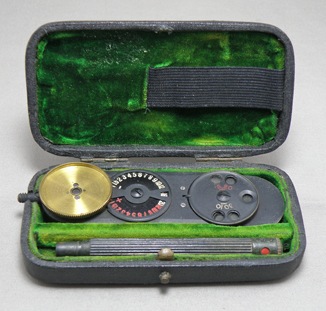Morton's Ophthalmoscope, cased
Catalogue Number: 3598 Morton's Ophthalmoscope, cased Category: Equipment Sub-Category: Ophthalmoscope Designer/inventor: Andrew Stanford MORTON Year Of Publication/Manufacture: c1895 Time Period: 19th C Place Of Publication/Manufacture: England Description Of Item: Cased example of Morton's ophthalmoscope in good condition except mirrors cracked. Black metal head, brass adjusting wheel. 3 mirrors to allow direct & indirect ophthalmoscopy. Non illuminated. Wheels of lenses to correct focus of patient &/or examiner. Black metal handle screws off for compact storage & includes colour dot test on the end. Missing condensing lens. Leatherette case, green velvet lined. Head: L 117 mm x W 33 mm Full length inc handle 200 mm. Case: L 117 mm x W 59 mm D 27 mm. Historical Significance: Ella Pink (1890-1986) was one of very few women optometrists when she commenced practice in Australia in 1917. She qualified in optometry in London in 1915 by passing the examinations for Fellowship of the Worshipful Company of Spectacle Makers, a London guild that was founded in 1629 and also obtained the Dioptric Diploma of the British Optical Association (DBOA) by examination. Passing these examinations entitled her to the postnominals DBOA and FSMC. Fellowship of the Worshipful Company of Spectacle Makers also qualified her for admission to the Freedom of the City of London. She is almost certainly the first Australian woman optometrist to obtain these qualifications.Helmholtz was the first to observe the human fundus with his Augenspiegel in 1851. Morton's ophthalmoscope was in the Curry and Paxton price list in London in 1883. Morton described his model to the Ophthalmological Society of the United Kingdom in January 1885. Morton used the lens arrangement that another ophthalmologist, John Couper, had reported in 1883. In 1882 George Lindsay Johnson of London introduced an ophthalmoscope with two mirrors fixed to a plate that could be rotated around a central pivot. In this way each mirror could be positioned quickly behind the sight hole with the smaller 3-inch focal length mirror rotatable around itself for left or right positioning. Later variations of this model featured three or four mirrors, in pairs back-to-back. Andrew Stanford Morton also of London adopted this system and popularised the non-illuminous and self-illuminated ophthalmoscopes bearing his name for over 40 years, but it was not so much the mirror arrangement as the elongated track of lenses for which he is best known. How Acquired: Donated by Noel Dawson (Estate of Ella Pink). Date Acquired: Jan 2018 Condition: Good (case & instrument) Location: Archive Office. Cabinet One Drawer 10 |


